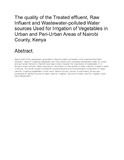Please use this identifier to cite or link to this item:
http://ir-library.mmust.ac.ke:8080/xmlui/handle/123456789/1821Full metadata record
| DC Field | Value | Language |
|---|---|---|
| dc.contributor.author | Rono, David K | - |
| dc.contributor.author | Gweyi, Joseph Onyango | - |
| dc.date.accessioned | 2021-12-14T11:59:17Z | - |
| dc.date.available | 2021-12-14T11:59:17Z | - |
| dc.date.issued | 2021-04 | - |
| dc.identifier.uri | https://doi.org/10.29322/IJSRP.11.05.2021.p11333 | - |
| dc.identifier.uri | http://www.ijsrp.org/research-paper-0521.php?rp=P11311262 | - |
| dc.identifier.uri | http://ir-library.mmust.ac.ke:8080/xmlui/handle/123456789/1821 | - |
| dc.description.abstract | Nearly half of the wastewater generated in Nairobi ended up treated in the treatment facilities. However, cases of irrigating vegetables with raw influent and untreated wastewater water by urban and peri-urban farmers in Nairobi have been noted. Despite the importance of wastewater in in Kenya’s urban and peri-urban agriculture, information on the quality of water used for irrigation areas is lacking. This study sought to establish physicochemical and microbiological composition of water used for irrigating vegetables in Ruai ward, Nairobi County, Kenya. A preliminary survey was conducted to identify sources of water used for irrigation. Sources of water used for irrigation were then categorized i | en_US |
| dc.language.iso | en | en_US |
| dc.publisher | International Journal of Scientific and Research Publications | en_US |
| dc.subject | quality ,Treated, effluent, Raw, Influent, Wastewater-polluted, Water, sources, Irrigation, Vegetables,Urban ,Peri-Urban Areas | en_US |
| dc.title | The quality of the treated effluent, raw influent and wastewater polluted water sourses used for irrigation of vegatabe in urban and Peri urbanAreas of Nairobi County, Kenya | en_US |
| dc.type | Article | en_US |
| Appears in Collections: | Journal Articles | |
Files in This Item:
| File | Description | Size | Format | |
|---|---|---|---|---|
| The quality of the Treated effluent.pdf | 303.4 kB | Adobe PDF |  View/Open |
Items in DSpace are protected by copyright, with all rights reserved, unless otherwise indicated.
